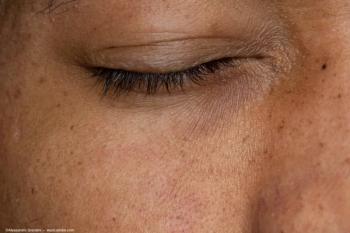
Cabozantinib linked to corneal perforation in patient with renal cell carcinoma
Key Takeaways
- Corneal perforation was observed in a patient treated with cabozantinib for advanced renal cell carcinoma, suggesting a potential ocular adverse effect.
- The patient's corneal ulcer recurred and perforated despite initial topical treatment, necessitating further interventions like therapeutic contact lens and amniotic membrane application.
Cabozantinib is a vascular endothelial growth factor receptor tyrosine kinase inhibitor, a drug used as a therapy for several malignancies.
Carmelo Laface, MD, and colleagues reported a case1 of corneal perforation associated with cabozantinib (Exelixis, Inc.), a vascular endothelial growth factor receptor tyrosine kinase inhibitor, a drug used as a therapy for several malignancies.2 He is from the Medical Oncology unit, Croce e Carle, Cuneo, Italy.
The most frequent adverse effects occurring with these drugs have been hepatic and dermatologic in nature.3-5
The investigators pointed out that limited data have been published on ocular adverse effects due to therapy with these drugs. One case of corneal perforation during treatment with a vascular endothelial growth factor receptor tyrosine kinase inhibitor, regorafenib (Stivarga, Bayer) has been reported,6 but there are no data about cabozantinib.
In this report, they described another clinical case of corneal perforation in a patient with advanced renal cell carcinoma and treated with cabozantinib as a second-line therapy.
The patient, a 78-year-old man, reported pain and vision loss in the right eye (a marginal corneal ulcer) after about 15 months of treatment with cabozantinib. His ocular history was unremarkable. All possible causes were excluded, including a history of ocular disease, contact trauma, exposure to damaging agents (e.g., chemical agents and prolonged use of drugs such as topical nonsteroidal anti-inflammatory drugs), infections, or dry eye. Topical treatment with ophthalmic ointment containing chloramphenicol 0.4%, colistin, and tetracycline 0.4% (Colbiocin, Sifi Spa, Catania, Italy) of 1-month’s duration was used until the ulcer re-epithelialized. The dose and administration regimen of cabozantinib stayed the same. However, the patient returned to the Ophthalmology Unit before the scheduled follow-up visit because the ulcer recurred and the cornea perforated.
The treatment with cabozantinib was suspected as the cause, a therapeutic contact lens was immediately fitted, and topical therapies with moxifloxacin 0.5%, netilmicin 0.3%, and atropine 1% drops were started. The patient underwent successful application of human amniotic membrane to close the corneal perforation and lateral tarsorrhaphy to reduce ocular exposure and enhance the healing process. The visual acuity was count fingers because of severe macular atrophy before the perforation. The patient ultimately died from renal cell carcinoma.
The investigators commented, “Cabozantinib may alter the ocular environment due to a lack of or imbalance in growth factors in the tear film, with a reduction in corneal epithelium proliferation. This condition might cause dry eye and a delay in corneal healing. Therefore, particular importance should be placed on ophthalmologic surveillance during treatment with these drugs in patients who develop ocular symptoms. Further in vitro and in vivo studies are necessary to deepen the knowledge about vascular endothelial growth factor receptor tyrosine kinase inhibitor-mediated ocular adverse events.”
References
Laface C, Scartozzi L, Pisano C, et al. Corneal perforation as a possible ocular adverse event caused by cabozantinib: a clinical case and brief review. J Clin Med. 2025; 14: 4052;
https://doi.org/10.3390/jcm14124052 Cheng K, Liu C-F, Rao G-W. Anti-angiogenic agents: a review on vascular endothelial growth factor receptor-2 (VEGFR-2) inhibitors. Curr Med Chem. 2021;28:2540–2564.
Abou-Alfa GK, Meyer T, Cheng A-L, et al. Cabozantinib in patients with advanced and progressing hepatocellular carcinoma. N Engl J Med. 2018;379:54–63.
Schlumberger M, Elisei R, Müller, et al. Overall survival analysis of EXAM, a phase III trial of cabozantinib in patients with radiographically progressive medullary thyroid carcinoma. Ann Oncol. 2017;28:2813–2819.
Choueiri TK, Escudier B, Powles T, et al. Cabozantinib versus everolimus in advanced renal cell carcinoma (METEOR): final results from a randomised, open-label, phase 3 trial. Lancet Oncol. 2016;17:917–927.
Lanfant L, Trone MC, Garcin T, Gauthier AS, Thuret G, Gain P. Corneal perforation with tyrosine kinase inhibitor chemotherapy: regorafenib. J Fr Ophtalmol. 2021;44:544–548
Newsletter
Don’t miss out—get Ophthalmology Times updates on the latest clinical advancements and expert interviews, straight to your inbox.


















































.png)


